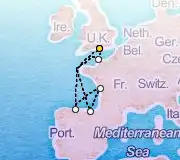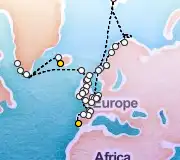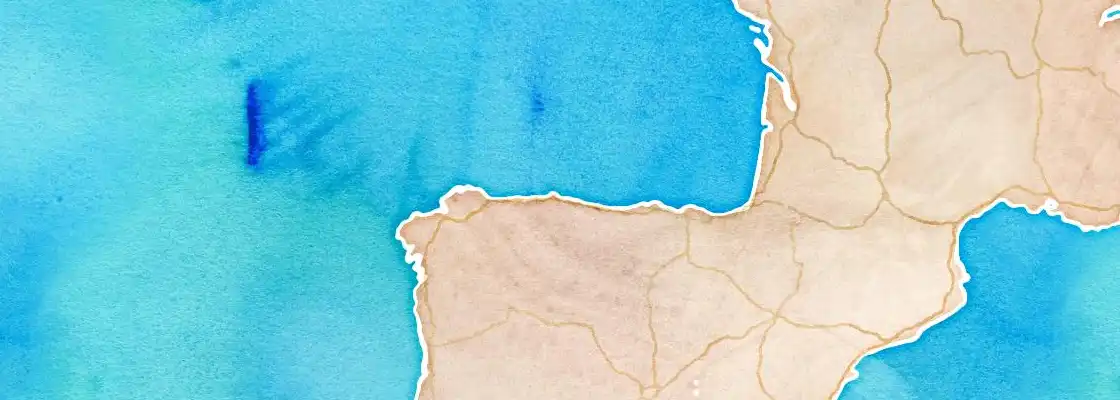The Port of Gijon, known as El Musel, is a major deep-water seaport located on the northern coast of Spain in the region of Asturias. As one of Spain's most important cargo ports on the Atlantic, it plays a vital role in the country's industrial logistics.
In recent years, Gijon has emerged as a compelling port of call for cruise ships exploring the Atlantic coasts of Spain and France. The port offers passengers a gateway to the lush, green landscapes and rich cultural heritage of Asturias, providing an alternative to the more common Mediterranean destinations. While primarily an industrial port, it has dedicated facilities to welcome cruise vessels and their passengers.
A top attraction is the historic fisherman's quarter, Cimavilla. This charming neighborhood is situated on a peninsula and features narrow, winding streets, traditional houses, and the Cerro de Santa Catalina park at its peak. The park is home to Eduardo Chillida's monumental sculpture, Elogio del Horizonte, which offers panoramic views of the sea.
Adjacent to Cimavilla is the impressive San Lorenzo Beach (Playa de San Lorenzo), a vast, crescent-shaped bay perfect for a relaxing stroll along its promenade. At the western end of the beach, you can find the Roman Baths of Campo Valdés, a well-preserved archaeological site offering a glimpse into the city's ancient past.
A short taxi or bus ride from the center is the Laboral Ciudad de la Cultura, a stunning and immense architectural complex that is the largest building in Spain. It features a church, a theater, and a 130-meter-tall tower with an observation deck.
Last updated on June 26, 2025
Oviedo, the capital of Asturias, is a popular day trip, located approximately 30 kilometers (18.6 miles) south of Gijon. The journey takes about 30 minutes by car or train. Oviedo is renowned for its charming medieval old town and its collection of pre-Romanesque churches, which are designated as a UNESCO World Heritage site.
For a scenic coastal excursion, the picturesque fishing village of Cudillero is about 55 kilometers (34 miles) to the west. It's famous for its colorful houses that cascade down a steep hillside to the harbor. The drive takes around 45 minutes.
A longer excursion can take you to the magnificent Picos de Europa National Park, home to the sacred site of Covadonga, approximately 90 kilometers (56 miles) away. This trip requires at least 1.5 hours of travel each way and offers breathtaking mountain scenery.
Last updated on June 26, 2025
Cruise ships visiting Gijon dock at the Port of El Musel, a large industrial and commercial port. It is located approximately 7 kilometers (4.3 miles) west of the main city center and its primary attractions.
Due to the distance and the industrial nature of the port surroundings, walking to the city center is not feasible or recommended. Cruise lines almost always provide shuttle buses, sometimes for a fee, that transport passengers to a convenient drop-off point near the marina or the city's beaches.
Taxis are also available at the cruise pier. The terminal area itself has very few passenger amenities, so all shopping, dining, and sightseeing activities are found within the city proper. Ships typically dock directly at the pier, so tendering is not common.
Last updated on June 26, 2025
The local currency in Gijon is the Euro (€).
While some tourist-focused establishments might accept US dollars, it is not common practice and the exchange rate will not be favorable. Major credit cards such as Visa and Mastercard are widely accepted in restaurants, hotels, and larger stores.
For cash, ATMs are abundant throughout the city center and are the most convenient way to get Euros. It is always advisable to carry some cash for smaller purchases at cafes, markets, or on public transport.
Last updated on June 26, 2025
Gijon is generally considered a very safe and welcoming city for tourists. The overall crime rate is low, and it is safe to explore the main tourist areas independently, both during the day and at night.
As in any city, visitors should exercise standard precautions. Be mindful of your belongings in crowded places like Calle Corrida or on public transportation to prevent petty theft or pickpocketing. There are no specific areas that tourists need to avoid.
Walking around the city center is safe and enjoyable. For excursions to more remote locations, a guided tour can be a convenient and safe option, but exploring on your own is also a perfectly viable choice.
Last updated on June 26, 2025
Gijon features a mild oceanic climate, typical of Spain's 'Green Coast.' This means moderate temperatures and a higher chance of rainfall compared to the southern parts of the country.
During the main cruise season from spring to autumn, weather is generally pleasant. Summer temperatures (June to August) typically range from 15°C to 22°C (59°F to 72°F), with a mix of sunny days and occasional showers. Spring and autumn are cooler, with temperatures between 10°C and 18°C (50°F to 64°F) and more frequent rain.
It is highly recommended to pack in layers. A light sweater or jacket and a waterproof outer layer or an umbrella are essential, even in summer, to be prepared for changing conditions. Comfortable walking shoes are a must for exploring the city.
Last updated on June 26, 2025
Cruise ships dock at El Musel, which is about 7 kilometers from the city center, so transportation is required. Cruise lines typically offer a shuttle bus service to a central location in Gijon.
Taxis are readily available at the cruise terminal for a direct trip into the city. Within Gijon, the city has an efficient public bus network managed by EMTUSA, which is useful for reaching attractions like the Laboral Ciudad de la Cultura. You can find more information on the official EMTUSA Gijón website.
Once in the city center, most key sights, including the Cimavilla old town and San Lorenzo Beach, are easily explored on foot.
Last updated on June 26, 2025
Gijon offers excellent shopping opportunities, primarily concentrated in the city center. The main pedestrian shopping street is Calle Corrida, along with its surrounding streets like Calle Moros and Calle Menéndez Valdés. Here you'll find a mix of popular Spanish brands, international retailers, and independent boutiques.
For local souvenirs, look for traditional Asturian products. Gastronomic specialties are particularly popular, including regional cheeses like Cabrales, and the famous Asturian cider (*sidra*), often sold in gift sets with a special glass. Local craft shops also sell ceramics and leather goods.
Prices in stores are fixed, and bargaining is not part of the local culture. For a modern mall experience, the Centro Comercial Los Fresnos offers a wide variety of shops under one roof.
Last updated on June 26, 2025











Showing 8 ships in the area
No ships scheduled in port today.
On average Gijon is rather inexpensive as a port of call. Prices are roughly the same throughout the year. Check out the illustration below for the monthly average cost per day.
Want to hear about the best deals and cruise tips every week? Sign up for our free weekly VIP Newsletter, customized exactly to your preferences!